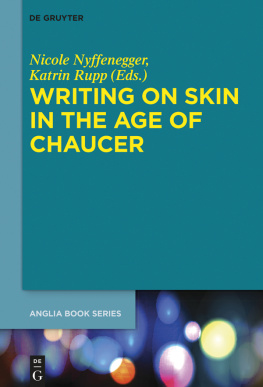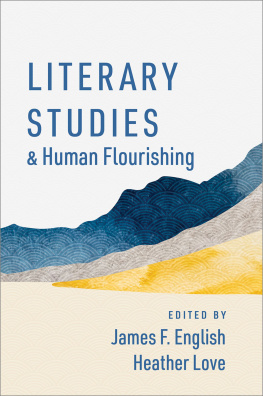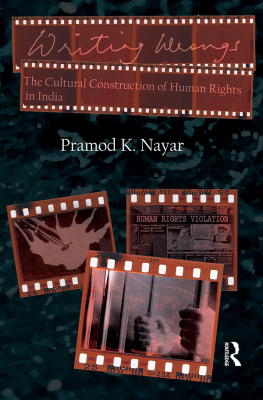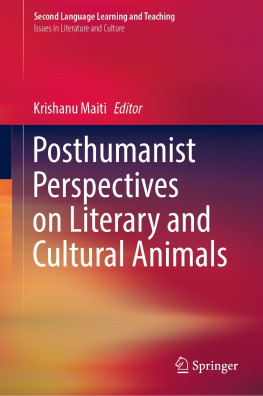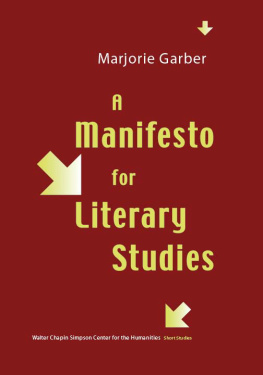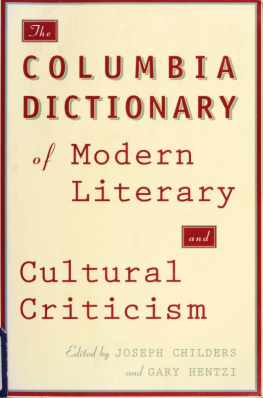Lundblad - Animalities literary and cultural studies beyond the human
Here you can read online Lundblad - Animalities literary and cultural studies beyond the human full text of the book (entire story) in english for free. Download pdf and epub, get meaning, cover and reviews about this ebook. City: Edinburgh, year: 2018, publisher: Edinburgh University Press, genre: Romance novel. Description of the work, (preface) as well as reviews are available. Best literature library LitArk.com created for fans of good reading and offers a wide selection of genres:
Romance novel
Science fiction
Adventure
Detective
Science
History
Home and family
Prose
Art
Politics
Computer
Non-fiction
Religion
Business
Children
Humor
Choose a favorite category and find really read worthwhile books. Enjoy immersion in the world of imagination, feel the emotions of the characters or learn something new for yourself, make an fascinating discovery.
- Book:Animalities literary and cultural studies beyond the human
- Author:
- Publisher:Edinburgh University Press
- Genre:
- Year:2018
- City:Edinburgh
- Rating:3 / 5
- Favourites:Add to favourites
- Your mark:
- 60
- 1
- 2
- 3
- 4
- 5
Animalities literary and cultural studies beyond the human: summary, description and annotation
We offer to read an annotation, description, summary or preface (depends on what the author of the book "Animalities literary and cultural studies beyond the human" wrote himself). If you haven't found the necessary information about the book — write in the comments, we will try to find it.
Lundblad: author's other books
Who wrote Animalities literary and cultural studies beyond the human? Find out the surname, the name of the author of the book and a list of all author's works by series.
Animalities literary and cultural studies beyond the human — read online for free the complete book (whole text) full work
Below is the text of the book, divided by pages. System saving the place of the last page read, allows you to conveniently read the book "Animalities literary and cultural studies beyond the human" online for free, without having to search again every time where you left off. Put a bookmark, and you can go to the page where you finished reading at any time.
Font size:
Interval:
Bookmark:

Animalities
Literary and Cultural Studies Beyond the Human
Edited by Michael Lundblad

Edinburgh University Press is one of the leading university presses in the UK. We publish academic books and journals in our selected subject areas across the humanities and social sciences, combining cutting-edge scholarship with high editorial and production values to produce academic works of lasting importance. For more information visit our website: edinburghuniversitypress.com
editorial matter and organisation Michael Lundblad, 2017
the chapters their several authors, 2017
Edinburgh University Press Ltd
The Tun Holyrood Road
12(2f) Jacksons
Entry Edinburgh EH8 8PJ
A CIP record for this book is available from the British Library
ISBN 978 1 4744 2396 0 (epub)
The right of Michael Lundblad to be identified as the editor of this work has been asserted in accordance with the Copyright, Designs and Patents Act 1988, and the Copyright and Related Rights Regulations 2003 (SI No. 2498).
Introduction: The End of the Animal Literary and Cultural Animalities
Michael Lundblad
1. Each Time Unique: The Poetics of Extinction
Cary Wolfe
2. Posthuman New York: Ground Zero of the Anthropocene
Neel Ahuja
3. J. G. Ballards Dark Ecologies: Unsettling Nature, Animals, and Literary Tropes
Frida Beckman
4. Staging Humanimality: Patricia Piccinini and a Genealogy of Species Intermingling
Sara E. S. Orning
5. Sparks Would Fly: Electricity and the Spectacle of Animality
Anat Pick
7. Animality, Biopolitics, and Umwelt in Amitav Ghoshs
The Hungry Tide
Robin Chen-Hsing Tsai
8. Looking the Beast in the Eye: Re-animating Meat in Nordic and British Food Culture
Karen Lykke Syse
10. Bestial Humans and Sexual Animals: Zoophilia in Law and Literature
Greg Garrard
I would like to thank the Department of Literature, Area Studies, and European Languages (ILOS) at the University of Oslo for its funding of an international symposium I organized on Animalities in Oslo in November 2014. This symposium provided an opportunity for many of the contributors to this volume to discuss and develop our potential chapters. I would also like to thank ILOS for its financial support in the preparation of the manuscript. My thanks as well to Jackie Jones at Edinburgh University Press for first approaching me about developing this project and for her support along the way. Adela Rauchova has also been a patient and encouraging editor and a pleasure to work with, along with all the other staff at the Press, including Rebecca Mackenzie on the cover design. I am grateful to all the contributors for their excellent work and for their patience throughout the process of pulling this book together. Finally, I want to acknowledge and thank my wife Sonya, my daughter Harper, and our dog Finn: masse spennende, ikke sant?
In , the photographs of Michael Pestels Requiem: Ectopistes Migratorius and Mel Chins Bird in a Cage appear courtesy of the artists.
In , the photograph of Alexis Rockmans Manifest Destiny appears courtesy of the artist.
In , the photographs of Patricia Piccininis work appear courtesy of the artist, Tolarno Galleries, and Roslyn Oxley9 Gallery.
Hvordan sier du animality studies p norsk? To what ends do we engage these various projects? How do literary and cultural studies in particular move beyond the human?
I think it will help to identify what I call animalities as objects of study that can be approached in three primary ways. Animalities is not a substitute for animal studies, but rather a set of dynamics that move beyond the human, to be defined as texts (broadly conceived, not just literary), discourses, and material relationships that construct animals, on the one hand, or humans in relation to animals, on the other hand, or both. My argument is that humanities and social-science approaches to animalities can be seen as taking three primary forms that can be defined more clearly: human-animal studies, animality studies, and posthumanism. These forms represent different priorities with different aims or ends in mind, rather than rigid distinctions without overlap. Within each of these approaches, I would argue, we can identify a different primary focus, different sub-fields and connections with other fields, and different sites of analysis within literary and cultural studies. Here, then, is my proposal for reorganizing these fields (see Table 1).
This taxonomy requires some further explanations, which can also serve to indicate how it relates to other recent attempts to define these various fields. My goal, then, is to specify more clearly the different aims and ends within what has previously been called animal studies.
Human-animal studies vs. animal studies
In their recent edited collection, the Routledge Handbook of Human-Animal Studies (2014), Garry Marvin and Susan McHugh make the case for human-animal studies rather than animal studies in ways that I believe have good potential. They sketch out the genealogy of this term in their introduction, In It Together: An Introduction to Human-Animal Studies, which argues that In human-animal studies the research and intellectual focus is on how animals figure and are configured in human worlds, but these worlds are formed through the relationships that humans share with animals. The key here, from my perspective, is on intertwined interactions, relationships, and becomings that involve human and nonhuman beings. While this emphasis might suggest the reinforcement of a singular binary between the human and the animal, Marvin and McHugh claim otherwise:
the hyphen in human-animal studies, signally a linking, together in one, is the thing that has come to mark a precise starting point, which is to study animals with humans, and humans with animals, never forgetting that we are both animals in general, and humans in particular.
While the hyphen can thus point to relationships, the retention of the term human also suggests an insistence that we cannot somehow avoid being human when we think about, represent, and interact with nonhuman animals, even if humans are seen as animals too. For McHugh, with a background in literary studies, and Marvin, with a background in social anthropology, we cannot talk, write, or even think about animals in any sense except in the context of humans, if only because we can never get away from ourselves.might then be critiqued by posthumanism, it can also be seen as a better way of distinguishing certain kinds of work in animal studies that focus specifically on humans interacting with nonhuman animals.
Table 1

Rather than claiming both human-animal studies and posthumanism as sub-fields of animal studies, then, it seems more productive to me to look at the ways they can be seen as distinct fields. Human-animal studies seems more closely aligned with an emphasis on advocacy, on better relationships and physical interactions, or better treatment of nonhuman animals. The prioritization of advocacy and activism has also been made in the distinction between critical animal studies and animal studies. Another recent book collection,
Font size:
Interval:
Bookmark:
Similar books «Animalities literary and cultural studies beyond the human»
Look at similar books to Animalities literary and cultural studies beyond the human. We have selected literature similar in name and meaning in the hope of providing readers with more options to find new, interesting, not yet read works.
Discussion, reviews of the book Animalities literary and cultural studies beyond the human and just readers' own opinions. Leave your comments, write what you think about the work, its meaning or the main characters. Specify what exactly you liked and what you didn't like, and why you think so.



